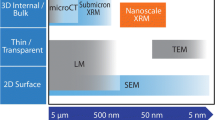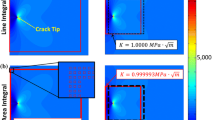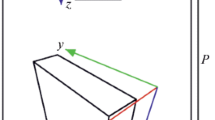Abstract
An understanding of the fatigue and fracture behavior of hard tissues (e.g., bone and tissues of the human tooth) is critical to the maintenance of physical and oral health. Recent studies suggest that there are a number of mechanisms contributing to crack extension and crack arrest in these materials, and that they appear to be a function of moisture and age of the tissue. An understanding of these processes can provide new ideas that are relevant to the design of multi-functional engineering materials. As a result, we have adopted the use of microscopic Digital Image Correlation (DIC) to examine the mechanisms of crack growth resistance and near-tip displacement distribution for cracks in human dentin that are subjected to opening mode loads. We have also developed a special compact tension (CT) specimen that permits evaluation of crack extension within small portions of tissue under both quasi-static and fatigue loads. The specimen embodies a selected portion of hard tissue within a resin composite restorative and enables an examination of diseased tissue, or portion with specific physiology, that would otherwise be impossible to evaluate. In this paper we describe application of these experimental methods and present some recent results concerning fatigue crack growth and stable crack extension in dentin and across the dentin-enamel-junction (DEJ) of human teeth.








Similar content being viewed by others
Notes
Optibond® Solo Plus resin adhesive, Kerr, Orange, CA (Lot #410833).
Ultra-Lume® LED 5 curing light; Ultradent Products, Inc, Provo, Utah.
Vit-l-escence resin composite; Ultradent, Provo, Utah (Lot #A0403).
SMZ-800 Steromicroscope; Nikon, Tokyo, Japan.
CV-A1 CCD camera; JAI America Inc., Laguna Hills, CA.
ABAQUS Version 6.5; ABAQUS Inc., Providence. RI.
References
Kinney JH, Marshall SJ, Marshall GW (2003) The mechanical properties of human dentin: a critical review and re-evaluation of the dental literature. Crit Rev Oral Biol Med 14:13–29.
Ten Cate AR (1998) Oral histology: development, structure, and function, 5th edn. Mosby-Year Book, St. Louis.
Xu HH, Smith DT, Jahanmir S, Romberg E, Kelly JR, Thompson VP, Rekow ED (1998) Indentation damage and mechanical properties of human enamel and dentin. J Dent Res 77(3):472–480.
Hassan R, Caputo AA, Bunshah RF (1981) Fracture toughness of human enamel. J Dent Res 60(4):820–827.
Imbeni V, Nalla RK, Bosi C, Kinney JH, Ritchie RO (2003) In vitro fracture toughness of human dentin. J Biomed Mater Res A 66(1):1–9.
Iwamoto N, Ruse ND (2003) Fracture toughness of human dentin. J Biomed Mater Res A 66(3):507–512.
Nalla RK, Kinney JH, Ritchie RO (2003) Effect of orientation on the in vitro fracture toughness of dentin: the role of toughening mechanisms. Biomaterials 24(22):3955–3968.
Kruzic JJ, Nalla RK, Kinney JH, Ritchie RO (2003) Crack blunting, crack bridging and resistance-curve fracture mechanics in dentin: effect of hydration. Biomaterials 24(28):5209–5221.
Arola D, Rouland JA, Zhang D (2002) Fatigue and fracture of bovine dentin. Exp Mech 42(4):380–388.
Nalla RK, Imbeni V, Kinney JH, Staninec M, Marshall SJ, Ritchie RO (2003) In vitro fatigue behavior of human dentin with implications for life prediction. J Biomed Mater Res A 66(1):10–20.
Bajaj D, Sundaram N, Nazari A, Arola D (2006) Age, dehydration and fatigue crack growth in dentin. Biomaterials 27(11):2507–2517.
Arola D, Rouland JA (2003) The effects of tubule orientation on fatigue crack growth in dentin. J Biomed Mater Res A 67(1):78–86.
Arola D, Zheng W, Sundaram N, Rouland JA (2005) Stress ratio contributes to fatigue crack growth in dentin. J Biomed Mater Res A 73(2):201–212.
Kruzic JJ, Nalla RK, Kinney JH, Ritchie RO (2005) Mechanistic aspects of in vitro fatigue-crack growth in dentin. Biomaterials 26(10):1195–1204.
Arola D, Reprogel RK (2005) Effects of aging on the mechanical behavior of human dentin. Biomaterials 26(18):4051–4061.
Marshall GW Jr, Balooch M, Gallagher RR, Gansky SA, Marshall SJ (2001) Mechanical properties of the dentinoenamel junction: AFM studies of nanohardness, elastic modulus, and fracture. J Biomed Mater Res 54(1):87–95.
Habelitz S, Marshall SJ, Marshall GW Jr, Balooch M (2001) The functional width of the dentino-enamel junction determined by AFM-based nanoscratching. J Struct Biol 135(3):294–301.
Lin CP, Douglas WH (1994) Structure-property relations and crack resistance at the bovine dentin-enamel junction. J Dent Res 73(5):1072–1078.
Imbeni V, Kruzic JJ, Marshall GW, Marshall SJ, Ritchie RO (2005) The dentin-enamel junction and the fracture of human teeth. Nat Matters 4(3):229–232.
White SN, Miklus VG, Chang PP, Caputo AA, Fong H, Sarikaya M, Luo W, Paine ML, Snead ML (2005) Controlled failure mechanisms toughen the dentino-enamel junction zone. J Prosthet Dent 94(4):330–335.
Dong XD, Ruse ND (2003) Fatigue crack propagation path across the dentinoenamel junction complex in human teeth. J Biomed Mater Res A 66(1):103–109.
Behiri JC, Bonfield W (1989) Orientation dependence of the fracture mechanics of cortical bone. J Biomech 22(8–9):863–872.
Zioupos P, Currey JD (1998) Changes in the stiffness, strength, and toughness of human cortical bone with age. Bone 22(1):57–66.
Phelps JB, Hubbard GB, Wang X, Agrawal CM (2000) Heterogeneity and the fracture toughness of bone. J Biomed Mater Res 51(4):735–741.
Lucksanasombool P, Higgs WA, Higgs RJ, Swain MV (2001) Fracture toughness of bovine bone: influence of orientation and storage media. Biomaterials 22(23):3127–3132.
Vashishth D (2004) Rising crack-growth-resistance behavior in cortical bone: implications for toughness measurements. J Biomech 37(6):943–946.
Nalla RK, Kruzic JJ, Kinney JH, Ritchie RO (2005) Mechanistic aspects of fracture and R-curve behavior in human cortical bone. Biomaterials 26(2):217–231.
Nalla RK, Stolken JS, Kinney JH, Ritchie RO (2005) Fracture in human cortical bone: local fracture criteria and toughening mechanisms. J Biomech 38(7):1517–1525.
Malik CL, Stover SM, Martin RB, Gibeling JC (2003) Equine cortical bone exhibits rising R-curve fracture mechanics. J Biomech 36(2):191–198.
Zhang D, Luo M, Arola D (2006) Displacement/strain measurement under optical microscope with digital image correlation. Opt Eng 45(3):1–9.
Chu TC, Ranson WF, Sutton MA, Peters WH (1985) Applications of digital-image-correlation techniques to experimental mechanics. Exp Mech 25(3):232–244.
Zhang D, Arola D (2004) Application of digital image correlation to biological tissues. J Biomed Opt 9(4):691–699.
Sachs C, Fabritius H, Raabe D (2006) Experimental investigation of the elastic-plastic deformation of mineralized lobster cuticle by digital image correlation. J Struct Biol 155(3):409–425.
Zhang J, Jin GC, Meng LB, Jian LH, Wang AY, Lu SB (2005) Strain and mechanical behavior measurements of soft tissues with digital speckle method. J Biomed Opt 10(3):034021, May–Jun.
Zhang D, Arola D, Reprogel R, Zheng W, Tasch U, Dyer RM (2006) A method for characterizing the mechanical behaviour of hoof horn. J Mat Sci (in press).
Zhang D, Arola D (2002) A new fast-search strategy for digital image correlation. In proceedings of the SEM annual conference on theoretical, experimental and computational mechanics. Milwaukee, Wisconsin, June 10–12, Paper no. 80.
ASTM Standard E399-05 (2005) Standard test method for linear elastic plane-strain fracture toughness (K Ic ) of metallic materials. Annual book of ASTM Standards, volume 03.01, ASTM, West Conshohocken, PA.
ASTM Standard E647-05 (2005) Standard test method for measurement of fatigue crack growth rates. Annual book of ASTM Standards, Volume 03.01, ASTM, West Conshohocken, PA.
Habelitz S, Marshall SJ, Marshall GW Jr, Balooch M (2001) Mechanical properties of human dental enamel on the nanometre scale. Arch Oral Biol 46(2):173–183.
Cuy JL, Mann AB, Livi KJ, Teaford MF, Weihs TP (2002) Nanoindentation mapping of the mechanical properties of human molar tooth enamel. Arch Oral Biol 47(4):281–291.
Kinney JH, Nalla RK, Pople JA, Breunig TM, Ritchie RO (2005) Age-related transparent root dentin: mineral concentration, crystallite size, and mechanical properties. Biomaterials 26:3363–3376.
Soappman M, Nazari A, Porter JD, Arola D (2006) A comparison of fatigue crack growth in resin composite, dentin and the interface. Dent Mater (in press).
Quinn GD (2006) Fracture toughness of ceramics by the vickers indentation crack length method: a critical review. Ceramic engineering and science proceedings, 2006 (in press), and Proceedings of the 30th international conference on advanced ceramics and composites, Cocoa Beach FL, January.
Yan J, Clifton KB, Reep RL, Mecholsky JJ (2006) Application of fracture mechanics to failure in manatee rib bone. J Biomech Eng 128(3):281–289.
Acknowledgement
This research was supported in part by the National Science Foundation (BES 0238237) and the American Association of Endodontists Foundation. The author A. Nazari wishes to acknowledge support from a GAANN Fellowship and the lead author would like to thank the Education Committee of Shanghai and Pujiang Project for partial support (Grant no. 04AB59).
Author information
Authors and Affiliations
Corresponding author
Rights and permissions
About this article
Cite this article
Zhang, D., Nazari, A., Soappman, M. et al. Methods for Examining the Fatigue and Fracture Behavior of Hard Tissues. Exp Mech 47, 325–336 (2007). https://doi.org/10.1007/s11340-006-9024-6
Received:
Accepted:
Published:
Issue Date:
DOI: https://doi.org/10.1007/s11340-006-9024-6




